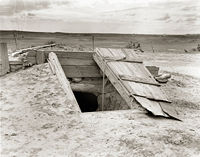| Revision as of 06:13, 22 June 2006 editVegaswikian (talk | contribs)270,510 editsm drop included cat, past a stub← Previous edit | Revision as of 14:48, 17 October 2006 edit undoRearden9 (talk | contribs)854 editsNo edit summaryNext edit → | ||
| Line 5: | Line 5: | ||
| A typical storm cellar for a single family would be built nearby the home. It might have a floor area of eight by twelve feet, (2.5 x 3.5 m) and an arched roof like that of a ] -- but it would be entirely underground. The entire structure would be built of bricks faced with cement. It would be reached by a covered stairwell, and at the opposite end of the structure there would be conduits for air that would reach the surface, and perhaps a small window to serve as an emergency exit and also to provide some light. | A typical storm cellar for a single family would be built nearby the home. It might have a floor area of eight by twelve feet, (2.5 x 3.5 m) and an arched roof like that of a ] -- but it would be entirely underground. The entire structure would be built of bricks faced with cement. It would be reached by a covered stairwell, and at the opposite end of the structure there would be conduits for air that would reach the surface, and perhaps a small window to serve as an emergency exit and also to provide some light. | ||
| ==Further reading== | |||
| ''The Secure Home'', Joel Skousen, Swift Learning Resources; 3rd ed, 1999 (ISBN 1568610556) | |||
| ] | ] | ||
| ] | ] | ||
| ] | ] | ||
| ] | |||
Revision as of 14:48, 17 October 2006

Storm cellars are underground structures that are either located below buildings, or are built underground near houses or other such buildings. They are reinforced structures into which residents can go for protection from a strong wind storm. They are common in areas that often have tornados and hurricanes.
A typical storm cellar for a single family would be built nearby the home. It might have a floor area of eight by twelve feet, (2.5 x 3.5 m) and an arched roof like that of a quonset hut -- but it would be entirely underground. The entire structure would be built of bricks faced with cement. It would be reached by a covered stairwell, and at the opposite end of the structure there would be conduits for air that would reach the surface, and perhaps a small window to serve as an emergency exit and also to provide some light.
Further reading
The Secure Home, Joel Skousen, Swift Learning Resources; 3rd ed, 1999 (ISBN 1568610556)
Categories: